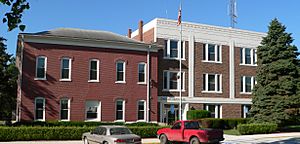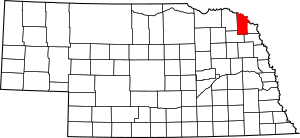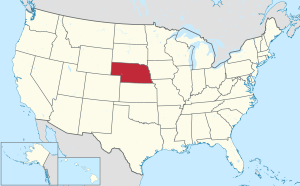Dixon County, Nebraska facts for kids
Quick facts for kids
Dixon County
|
|
|---|---|

Dixon County courthouse in Ponca
|
|

Location within the U.S. state of Nebraska
|
|
 Nebraska's location within the U.S. |
|
| Country | |
| State | |
| Founded | 1856 (authorized) 1858 (organized) |
| Seat | Ponca |
| Largest city | Wakefield |
| Area | |
| • Total | 483 sq mi (1,250 km2) |
| • Land | 476 sq mi (1,230 km2) |
| • Water | 6.7 sq mi (17 km2) 1.4%% |
| Population
(2020)
|
|
| • Total | 5,606 |
| • Estimate
(2022)
|
5,464 |
| • Density | 11.607/sq mi (4.481/km2) |
| Time zone | UTC−6 (Central) |
| • Summer (DST) | UTC−5 (CDT) |
| Congressional district | 3rd |
Dixon County is a county in the state of Nebraska, USA. It is located in the northeastern part of the state. In 2020, about 5,606 people lived there. The main town and county seat is Ponca.
The county was officially formed in 1856 and got organized in 1858. Dixon County is also part of the Sioux City metropolitan area, which includes parts of Iowa, Nebraska, and South Dakota. If you see a Nebraska license plate with the number 35, it means the vehicle is from Dixon County!
Contents
A Look Back in Time
Dixon County was created in 1856. It was named after an early settler in the area. The county officially started operating in 1858.
Where is Dixon County?
Dixon County is in the northeast corner of Nebraska. The Missouri River forms its northern border, separating it from South Dakota. The county covers about 483 square miles. Most of this area is land, with a small part being water.
Main Roads You Might See
These are some of the important highways that go through Dixon County:
Special Natural Areas
Dixon County has some beautiful natural spots. These areas help protect nature and offer places for people to visit.
National Protected Area
- Missouri National Recreational River (part) - This area protects a section of the Missouri River.
State Protected Areas
- Buckskin Hills State Wildlife Management Area
- Ponca State Park - A popular park for outdoor activities.
- Tarbox Hollow Living Prairie
Neighboring Counties
Dixon County shares its borders with these other counties:
- Union County, South Dakota - to the northeast
- Dakota County - to the east
- Thurston County - to the southeast
- Wayne County - to the southwest
- Cedar County - to the west
- Clay County, South Dakota - to the northwest
Who Lives in Dixon County?
| Historical population | |||
|---|---|---|---|
| Census | Pop. | %± | |
| 1860 | 274 | — | |
| 1870 | 1,345 | 390.9% | |
| 1880 | 4,177 | 210.6% | |
| 1890 | 8,084 | 93.5% | |
| 1900 | 10,535 | 30.3% | |
| 1910 | 11,477 | 8.9% | |
| 1920 | 11,815 | 2.9% | |
| 1930 | 11,586 | −1.9% | |
| 1940 | 10,413 | −10.1% | |
| 1950 | 9,129 | −12.3% | |
| 1960 | 8,106 | −11.2% | |
| 1970 | 7,453 | −8.1% | |
| 1980 | 7,137 | −4.2% | |
| 1990 | 6,143 | −13.9% | |
| 2000 | 6,339 | 3.2% | |
| 2010 | 6,000 | −5.3% | |
| 2020 | 5,606 | −6.6% | |
| 2022 (est.) | 5,464 | −8.9% | |
| US Decennial Census 1790-1960 1900-1990 1990-2000 2010 2020 2022 |
|||
In 2020, the population of Dixon County was 5,606 people. The county has seen its population change over the years. Many different people and families make their homes here.
Towns and Villages
Dixon County has several communities where people live, work, and go to school.
Cities
Villages
Unincorporated Community
- Lime Grove (This is a small community without its own local government.)
Townships
Townships are smaller areas within the county, often used for local administration.
- Clark
- Concord
- Daily
- Emerson
- Galena
- Hooker
- Logan
- Newcastle
- Ottercreek
- Ponca
- Silvercreek
- Springbank
- Wakefield
Schools in Dixon County
Students in Dixon County attend schools in these districts:
- Allen Consolidated Schools
- Emerson-Hubbard Public Schools
- Hartington Newcastle Public Schools
- Laurel-Concord-Coleridge School
- Ponca Public Schools
- Wakefield Public Schools
- Wayne Community Schools
- Wynot Public Schools
Images for kids
See also
 In Spanish: Condado de Dixon para niños
In Spanish: Condado de Dixon para niños

